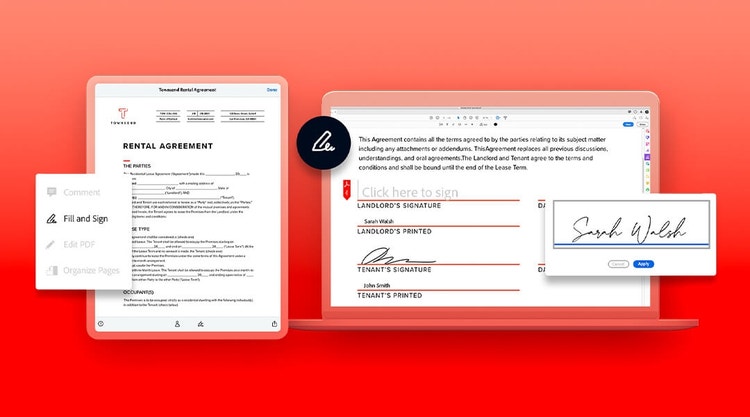Adobe Acrobat
Make a basic house rental agreement that brings the deal home.
Before anyone moves in or pays a month’s rent, a landlord and tenant need to agree on a rental contract. Find out what goes into one and how to make signing it easier.

What is a house rental agreement?
A house rental agreement is the legal document homeowners and renters sign before occupancy begins. After renters have put in a rental application and been accepted by the landlord or property manager, they need to agree on a contract to handle rent payments, repairs, late rent, and other issues. This is true for spaces large and small and for any period of time. Even if it’s just a simple room rental for one month, you need a written contract.
Though the two terms are often used interchangeably, rental agreements are distinct from lease agreements. Standard lease agreements have an end date when the tenant is expected to either move out or renew the agreement, usually after one year. Rental agreements, however, are not fixed-term and usually work on a month-to-month basis. They can be very short-term or, if they are renewed each month, last indefinitely.

What to include in a house rental agreement.
A rental agreement or residential lease agreement usually includes:
- Location of the rental property
- Start date of occupancy
- Names of all tenants
- Term of the tenancy, usually monthly
- Amount of the security deposit
- Amount of time for each pay period of the rental, usually monthly
- Amount of each month’s rent
- Preferred way to make rent payments
- Due date for rent each month
- Security deposits and other fees
- Framework for handing repairs and maintenance, indoors and out
- What happens in the event of illegal activity
- Agreements regarding pets
- Rules for common areas or shared spaces, if any
- Who has right of entry to the property
- Rules regarding subleasing and subletting
- How to handle damages or alterations to the premises
- Late fees, in the event that tenants are late with monthly rent
- Rules regarding eviction
Protect tenant privacy.
Tenant privacy is also a crucial part of a rental agreement. Even though a landlord might own the property, renters and lessees have the right to enter and be on premises on a daily basis. In most cases, landlords or property managers need to give notice to occupants before entering the property. A rental or lease contract needs to reflect this rule, even for something as temporary as a one-month rental agreement.

What not to do when considering a rental agreement.
When renting out a house, apartment, or section of a property, you’re not allowed to discriminate based on race, sex, gender presentation, age, religion, or nationality. You also can’t discriminate based on family or marital status.
Some landlords might prefer renting to married couples, and some might prefer single people. But they aren’t allowed to discriminate based on these factors when deciding on tenants that they rent to. From a landlord’s perspective, there can’t be a distinction between someone living with a roommate or living with a spouse or family member with regards to tenant applications.
Make good on your promises.
If your agreement specifies that you’ll mow the lawn every week, be sure it happens. It can be tempting to try and attract tenants with a variety of services, but don’t over-promise.
Do some research and seek legal advice.
Before you put together a rental contract, be sure to familiarize yourself with the relevant state laws and local regulations. Consult a legal professional to understand your rights and obligations under laws.

Create better rental agreements.
House rental agreements can be high stakes and high stress for homeowners and renters alike. One way to make them easier for everyone is to go digital. Electronic contracts and electronic signatures are binding and enforceable in nearly every industrialized country around the world, and many less-developed countries are beginning to enact e-signature laws as well.
Create a template for rental agreements.
If you’re a landlord who owns several properties or a property manager who has to deal with new tenants on a regular basis, you should have rental or lease agreement templates for your residential property. Explore how to create templates in Adobe Acrobat for your home rental agreements and other necessary documentation, like sublease agreements.
Sign, fill out, and manage forms electronically.
Rental contracts are not the only kind of agreements between a landlord and tenant. Occasionally the owners and occupants of a residential property have to deal with paperwork around repairs for regular wear and tear, changes to the amount of rent due each month, or changing a short-term rental into a long-term lease.
When these issues come up, have online forms ready to go: Find out how to fill and sign forms online or gather signatures for new issues or addendums to the terms of the agreement.

Make house rental agreements easier with Adobe.
A rental agreement is a crucial document. Both parties need to be able to access the document easily to check on the details or to renegotiate terms at the end of the rental period. Adobe Acrobat Pro makes it easy for everyone involved to review, examine, and sign contracts. Create templates from your agreements, gather signatures digitally, and make renting, leasing, and housing easier for everyone with Acrobat.
